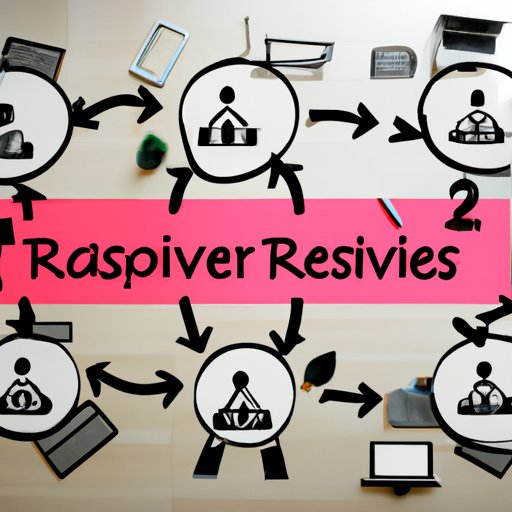Introduction
Reverse logistics is a key component of supply chain management that involves the process of returning items from the end consumer to their original point of manufacture or distribution. These items can be defective or unwanted products, or even excess inventory. Reverse logistics helps businesses reduce costs, increase customer satisfaction, and improve overall supply chain performance.
Explaining the Basics of Reverse Logistics in Supply Chain Management
The reverse logistics process typically begins when a customer returns a product to the retailer. The retailer then assesses the condition of the returned item, determines if it can be resold, and if not, decides how to dispose of it. The product can then be sent back to the manufacturer or distributor for repair, repackaging, or recycling. According to a study by the International Journal of Logistics Research and Applications, “Reverse logistics is becoming increasingly important as companies recognize the value of recovering value from returned goods.”
There are several different types of reverse logistics processes, including product recalls, repairs and maintenance, returns and warranties, and excess inventory management. Product recalls involve the removal of potentially hazardous products from the market. Repairs and maintenance refer to the return of products for repair or refurbishment. Returns and warranties involve the return of products that do not meet customer expectations or that have malfunctioned. Lastly, excess inventory management refers to the return of products that are no longer needed.

Analyzing the Benefits of Using Reverse Logistics in Supply Chain Management
Using reverse logistics in supply chain management has several benefits, including improved customer satisfaction, reduced costs, and increased revenue. Improved customer satisfaction is one of the most significant benefits of using reverse logistics. A study by the International Journal of Physical Distribution and Logistics Management found that “the ability to manage returns efficiently and effectively can help organizations to build strong relationships with customers and enhance their loyalty.”
Using reverse logistics can also help reduce costs by reducing the amount of waste associated with disposing of returned products. Additionally, businesses can use reverse logistics to generate additional revenue by reselling returned products or by selling parts or components from returned items.
Outlining the Challenges of Implementing Reverse Logistics in Supply Chain Management
Although there are many benefits of using reverse logistics in supply chain management, there are also some challenges associated with implementation. One of the biggest challenges is identifying which products should be returned. It is important for businesses to have an accurate system for tracking returns and determining which products need to be returned. Additionally, businesses must be able to track the returned products to ensure they are properly disposed of.
Another challenge associated with reverse logistics is managing the disposal of returns. Depending on the type of product being returned, businesses may need to find ways to safely and responsibly dispose of the product. This can be a time-consuming and costly process, so it is important for businesses to plan ahead and establish a clear policy for disposing of returns.
Examining the Impact of Reverse Logistics on Overall Supply Chain Performance
Using reverse logistics in supply chain management can have a positive impact on overall supply chain performance. Reverse logistics can help improve efficiency by streamlining the process of returning products and increasing visibility into the returns process. Additionally, using reverse logistics can help improve transparency by providing businesses with real-time insights into the status of returned products. Finally, using reverse logistics can improve profitability by reducing costs and increasing revenue.

Investigating the Role of Technology in Reverse Logistics Processes
Technology plays an important role in the success of reverse logistics processes. Automation can be used to streamline the process of returning products and reduce manual errors. Additionally, data collection and analysis tools can be used to gain valuable insights into the returns process, such as identifying patterns in returns and predicting future returns. Finally, advanced visibility solutions can be used to monitor the progress of returns and ensure they are handled in a timely manner.

Discussing Best Practices for Managing Reverse Logistics in Supply Chain Management
In order to ensure the success of reverse logistics processes, businesses should establish clear policies and procedures for managing returns. These policies should include guidelines for determining which products should be returned, establishing a return authorization system, and setting up automation and analytics tools to streamline the process. Additionally, businesses should establish a system for tracking and disposing of returned products in a responsible manner.
Conclusion
Reverse logistics is an important part of supply chain management that can help businesses reduce costs, increase customer satisfaction, and improve overall supply chain performance. By understanding the basics of reverse logistics, analyzing the benefits and challenges of implementing it, and investigating the role of technology, businesses can ensure the success of their reverse logistics processes. Additionally, businesses should establish clear policies and procedures for managing returns and utilize automation and analytics tools to streamline the process.
(Note: Is this article not meeting your expectations? Do you have knowledge or insights to share? Unlock new opportunities and expand your reach by joining our authors team. Click Registration to join us and share your expertise with our readers.)
